
British postcard in the Picturegoer Series, London, no. D 554. Photo: J. Arthur Rank Organisation. Laurence Harvey and Susan Shentall in Romeo and Juliet (Renato Castellani, 1954).
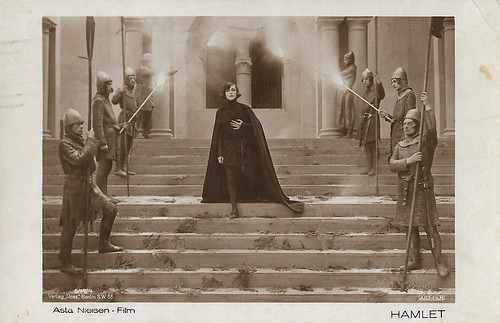
German postcard by Verlag Ross, Berlin, no. 644/4. Photo: Art-Film / Asta Nielsen-Film. Asta Nielsen as Hamlet in Hamlet (Svend Gade, Heinz Schall, 1921). Asta Nielsen had produced the film herself.

French postcard by Edition de la Cinématographie-Française, Paris. Photo: G.P.C. Emil Jannings as Othello and Werner Krauss as Jago in Othello (Dimitri Buchowetzki, 1922).

German postcard by Ross Verlag, no. 658/1. Photo: Peter Paul Felner-Film Co. Henny Porten and Lia Eibenschütz in Der Kaufmann von Venedig/The Merchant of Venice (Peter Paul Felner, 1923).

Vintage postcard. Photo: 20th Century Fox. Jamie Kennedy, Zak Orth, Leonardo DiCaprio, Dash Mihok, and Harold Perrineau in Romeo + Juliet (Baz Luhrmann, 1996). Caption: Montague. Quarrel I Will Back Thee.
A gender-bending Hamlet
In the 1900s, when the silent film industry began to develop in Europe and America, plays by Shakespeare made up a small part of the total production. The public domain status of Shakespeare's plays made them attractive to film producers, who did not have to feel bound to remain faithful to the originals.
The earliest known production is King John (1899) with Sir Herbert Beerbohm Tree by the London studio of the British Mutoscope and Biograph Company. It was a scene from Shakespeare’s 'King John' which was then on the boards at Her Majesty’s Theatre, recorded on 68-mm film. Of four excerpts shot and later exhibited at London’s Palace Theatre to promote the stage production, only the death scene (Act V, scene 2), long thought lost, resurfaced in 1990 in the archive of Eye Filmmuseum in Amsterdam.
In 1900, 'Hamlet' was filmed in France, with Sarah Bernhardt somewhat unexpectedly in the title role. Bernhardt appeared on-screen at the Paris Exposition in the duel scene from 'Hamlet'. In France and Italy at that time, the film was not considered a separate art form, but a medium to present the art of traditional theatre. This movement that cast high-profile actors in adaptations of famous plays, was given the name 'Film d'Art' in 1907.
In the United States, the film industry was initially propelled by a few thousand cheap and widespread 'nickelodeons' (cinematographs). American filmmakers then began to strive to attract the attention of the upper class as well. Possibly, they were also influenced by the 'Film d'Art' spirit. The themes of their films shifted from stories about contemporary workers to classical works.
Filmmakers also responded to demands from religious groups and authorities to reduce the amount of violence shown in historical films. Shakespeare's plays were widely respected by both the upper and lower classes of American society, and their public domain status avoided copyright issues. One of the best-known Shakespeare film studios of the time was Vitagraph in New York. Brooklyn’s Prospect Park served as one location for A Midsummer Night’s Dream (1909), and Central Park’s Bethesda Fountain doubled as a Veronese street in Romeo and Juliet (1908).
Directors Svend Gade and Heinz Schall came up with a gender-bending Hamlet (1920), which starred Asta Nielsen as a cross-dressed prince. Emil Jannings played the title role in Othello (1922) to Werner Krauss’s Iago. Krauss also portrayed Shylock in a free adaptation of The Merchant of Venice, Der Kaufmann von Venedig (1923).
In the United States, Mary Pickford played a saucy Kate opposite Douglas Fairbanks as Petruchio in The Taming of the Shrew (1929), the first feature-length sound film of Shakespeare. With her sly wink to Bianca during the 'submission' speech to Petruchio, she showed how the film could subvert the Shakespearean text.
Warner Brothers’ A Midsummer Night’s Dream (1935), directed by émigrés Max Reinhardt and William Dieterle, revealed the influence of Weimar Expressionism, but it combined the incidental music of Felix Mendelssohn with the presence of contract actors James Cagney and Mickey Rooney, who played Bottom and Puck, respectively. Almost immediately thereafter, producer Irving Thalberg and director George Cukor offered a reverential Romeo and Juliet (1936), with Norma Shearer and Leslie Howard and a supporting cast of actors from the Hollywood expatriate British colony.

French postcard by A.N., Paris, no. 141. Image: E.D. William Shakespeare.
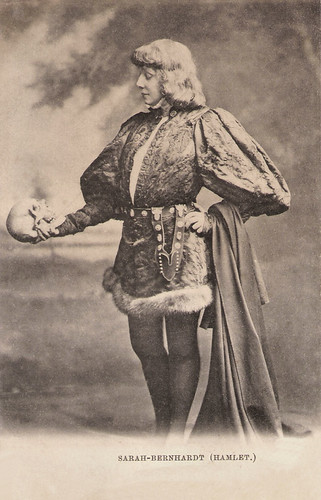
French postcard. Sarah Bernhardt in the title role of William Shakespeare's 'Hamlet' (1899).

Italian postcard for the film Amleto/Hamlet (Eleuterio Rodolfi, 1917), adapted from Shakespeare's play 'Hamlet', and starring Ruggero Ruggeri in the title role, here also with Mercedes Brigone as Hamlet's mother, Queen Gertrude, while Polonius spies between the curtains. Caption: Hamlet: You mother, you committed a grave offense to my father.
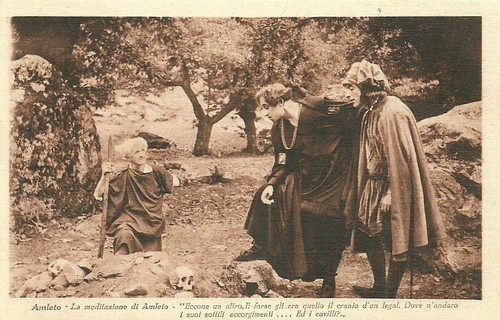
Italian postcard. Ruggero Ruggeri as Hamlet in Amleto/Hamlet (Eleuterio Rodolfi, 1917). Hamlet's meditation: 'There's another: why may not that be the skull of a lawyer? Where be his quiddities now, his quillets, his cases, his tenures, and his tricks?' (Shakespeare).
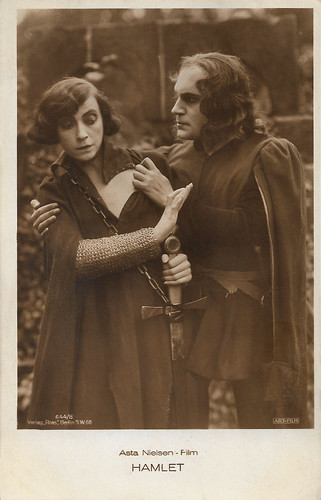
German postcard by Ross Verlag, Berlin, no. 644/8, 1919-1924. Photo: Art-Film. Asta Nielsen as Hamlet and Heinz Stieda as Horatio in Hamlet (Svend Gade, Heinz Schall, 1921).
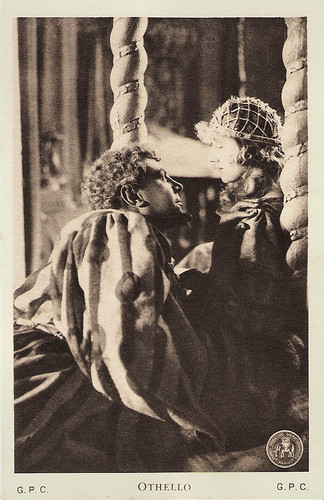
French postcard by Edition de la Cinematographie Française. Photo: Grandes Productions Cinématographiques (G.P.C.). Emil Jannings and Ica von Lenkeffy in Othello (Dimitri Buchowetzki, 1922).
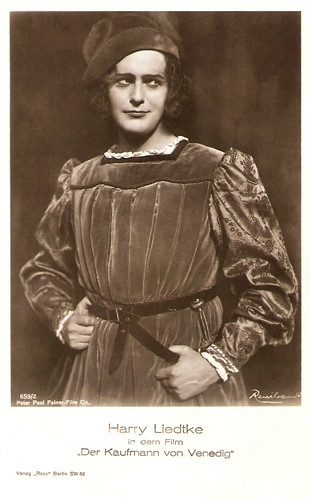
German postcard by Ross Verlag, no. 659/2, 1919-1924. Photo: Rembrandt / Peter Paul Felner Film Co. Harry Liedtke in Der Kaufmann von Venedig/The Merchant Of Venice (Peter Paul Felner, 1923).
Blowing the dust of Rome and Julia
The numerous film adaptations of 'Romeo and Juliet' (1597) show how popular, flexible, and timeless Shakespeare's oeuvre is. Kevin Toma, a critic of the Dutch newspaper De Volkskrant noted that the love tragedy has been adapted for the big screen into zombie comedy (Warm Bodies, 2013), action film (Romeo Must Die, 2000), musical (West Side Story, 1961/2021) and everything in between.
Toma: "As far as text-based film adaptations go, two stand out. Thanks to Romeo and Juliet (Franco Zeffirelli, 1968) and Romeo + Juliet (Baz Luhrmann, 1996), entire generations of filmgoers became addicted to Shakespeare's doomed lovers. Zeffirelli was the first film director to cast his protagonists more or less in the age of their characters. Juliet is 13, Romeo is probably a little older, around 17. Exactly the age of performer Leonard Whiting, while co-star Olivia Hussey was 16 during filming. The two still effortlessly draw you into the immaculate love that Romeo and Juliet feel for each other, and which they try to shield from the bloody feud in which their families find themselves. And how about a more intimate version of the nocturnal balcony scene?
Baz Luhrmann blew the dust off the play in a different way. The location of Romeo + Juliet is no longer 15th-century Verona, but the contemporary fictional town of Verona Beach, where the Capulets and Montagues make things unsafe as rival gangs of thugs. In this sandy setting, Shakespeare's verses go hand in hand with a flashy, restless style that refers as easily to spaghetti westerns as it does to the James Dean classic Rebel without a Cause (Nicholas Ray, 1955).
As far as Luhrmann was concerned, this was entirely in keeping with the Elizabethan theatre tradition of Shakespeare's time, when consistent dramatic style was frowned upon. The sombre tone of 'Romeo and Juliet' can sometimes suddenly become comic, and Luhrmann felt that a contemporary adaptation should make these changes of pace and atmosphere comprehensible to a new audience.
It is the youthful heroes, unforgettably portrayed by Leonardo DiCaprio and Claire Danes, who provide resting points with their forbidden romance: how tender, poetic and romantic it remains, the scene in which the two cast each other's distant glances on either side of an aquarium, the fish swimming between their eyes and lips."

German postcard by Ross-Verlag, no. 5212/2, 1930-1931. Photo: K.O. Rahmn (Knut Olaf Rahmn) / United Artists. Douglas Fairbanks in The Taming of the Shrew (Sam Taylor, 1930).
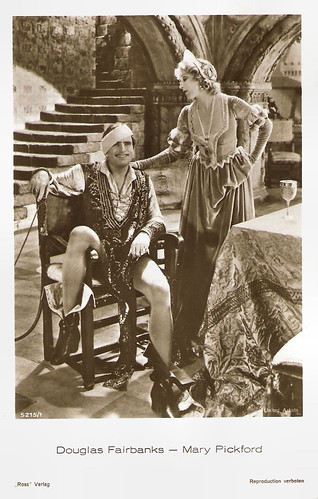
German postcard by Ross-Verlag, no. 5215/1 1930-1931. Photo: K.O. Rahmn (Knut Olaf Rahmn) / United Artists. Douglas Fairbanks and Mary Pickford in The Taming of the Shrew (Sam Taylor, 1930).

British postcard by Real Photograph, no. 103. Photo: Metro-Goldwyn-Mayer Pictures. Leslie Howard and Norma Shearer in Romeo and Juliet (George Cukor, 1936).

British postcard by Rotary Photo, London, nr. F.S.5. Photo: Laurence Olivier directs a scene in Hamlet (1948).
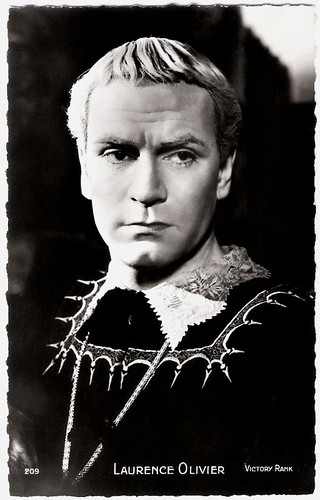
French postcard by Editions P.I., Paris, no. 209. Photo: Victory Rank. Laurence Olivier in Hamlet (Laurence Olivier, 1948).

British postcard in the Picturegoer Series, London, no. D 551. Photo: J. Arthur Rank Organisation. Laurence Harvey as Romeo in Romeo and Juliet (Renato Castellani, 1954).
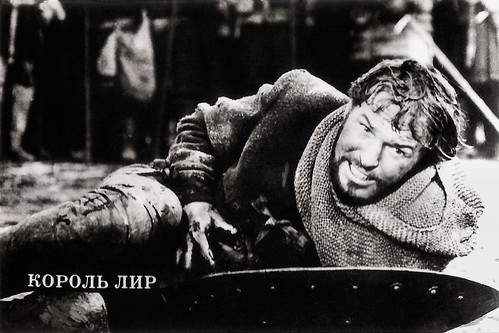
Soviet collectors card. Photo: Regimantas Adomaitis in Korol Lir/King Lear (Grigori Kozintsev, Iosif Shapiro, 1971).
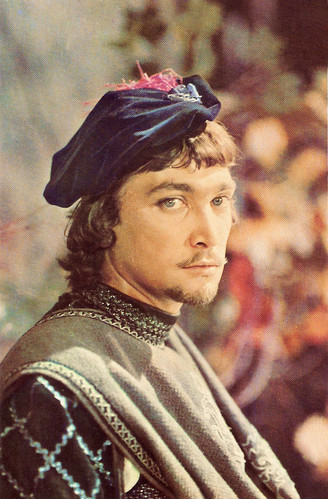
Soviet postcard by Izdanije Byuro Propogandy Sovietskogo Kinoiskusstva. This postcard was printed in an edition of 200.000 cards. The price was 5 kop. Vladimir Korenev in Mnogo shuma iz nichego/Much Ado About Nothing (Samson Samsonov, 1973).
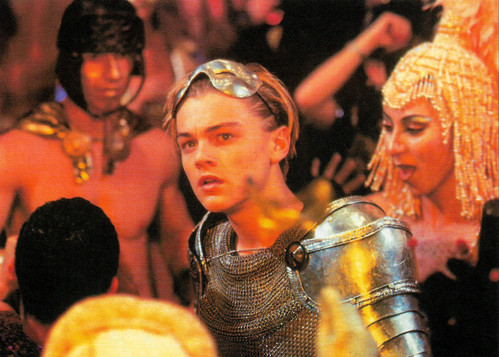
Vintage postcard. Leonardo DiCaprio in Romeo + Juliet (Baz Luhrmann, 1996).
Sources: Kevin Toma (De Volkskrant - Dutch), Kenneth S. Rothwell (Encyclopaedia Britannica), and Wikipedia (Dutch.)
No comments:
Post a Comment